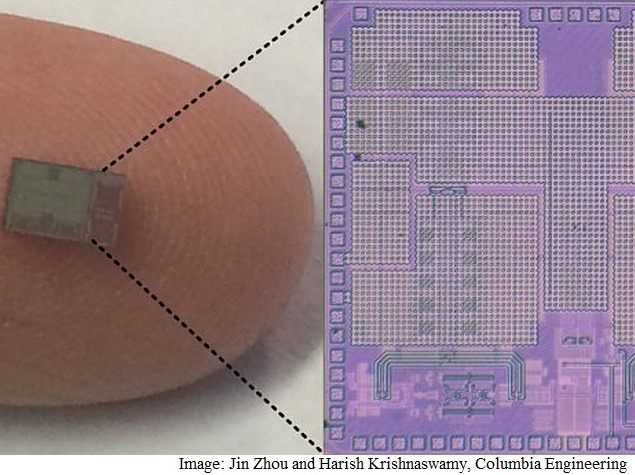- Home
- Science
- Science News
- New Radio IC Technology May Double Data Capacity of Networks: Study
New Radio IC Technology May Double Data Capacity of Networks: Study

Researchers have invented full-duplex radio integrated circuits (ICs) that can enable simultaneous transmission and reception on the same frequency in a wireless radio.
Up to now, this has been thought to be impossible: transmitters and receivers either work at different times or at the same time but at different frequencies.
The Columbia University team, led by Electrical Engineering Associate Professor Harish Krishnaswamy, is the first to demonstrate an IC that can accomplish this.
"This is a game-changer. By leveraging our new technology, networks can effectively double the frequency spectrum resources available for devices like smartphones and tablets," said Krishnaswamy.
In the era of Big Data, the current frequency spectrum crisis is one of the biggest challenges researchers are grappling with and it is clear that today's wireless networks will not be able to support tomorrow's data deluge, researchers said.
Today's standards, such as 4G/LTE, already support 40 different frequency bands, and there is no space left at radio frequencies for future expansion.
At the same time, the grand challenge of the next-generation 5G network is to increase the data capacity by 1,000 times.
The ability to have a transmitter and receiver re-use the same frequency has the potential to immediately double the data capacity of today's networks.
Krishnaswamy notes that other research groups and startup companies have demonstrated the theoretical feasibility of simultaneous transmission and reception at the same frequency, but no one has yet been able to build tiny nanoscale ICs with this capability.
"Our work is the first to demonstrate an IC that can receive and transmit simultaneously," he said.
"Doing this in an IC is critical if we are to have widespread impact and bring this functionality to handheld devices such as cellular handsets, mobile devices such as tablets for WiFi, and in cellular and WiFi base stations to support full duplex communications," said Krishnaswamy.
The biggest challenge the team faced with full duplex was cancelling the transmitter's echo.
Imagine that you are trying to listen to someone whisper from far away while at the same time someone else is yelling while standing next to you. If you can cancel the echo of the person yelling, you can hear the other person whispering, researchers said.
"If everyone could do this, everyone could talk and listen at the same time, and conversations would take half the amount of time and resources as they take right now," said Jin Zhou, Krishnaswamy's PhD student and the paper's lead author.
"Transmitter echo or 'self-interference' cancellation has been a fundamental challenge, especially when performed in a tiny nanoscale IC, and we have found a way to solve that challenge," Krishnaswamy added.
Get your daily dose of tech news, reviews, and insights, in under 80 characters on Gadgets 360 Turbo. Connect with fellow tech lovers on our Forum. Follow us on X, Facebook, WhatsApp, Threads and Google News for instant updates. Catch all the action on our YouTube channel.
Related Stories
- Samsung Galaxy Unpacked 2025
- ChatGPT
- Redmi Note 14 Pro+
- iPhone 16
- Apple Vision Pro
- Oneplus 12
- OnePlus Nord CE 3 Lite 5G
- iPhone 13
- Xiaomi 14 Pro
- Oppo Find N3
- Tecno Spark Go (2023)
- Realme V30
- Best Phones Under 25000
- Samsung Galaxy S24 Series
- Cryptocurrency
- iQoo 12
- Samsung Galaxy S24 Ultra
- Giottus
- Samsung Galaxy Z Flip 5
- Apple 'Scary Fast'
- Housefull 5
- GoPro Hero 12 Black Review
- Invincible Season 2
- JioGlass
- HD Ready TV
- Laptop Under 50000
- Smartwatch Under 10000
- Latest Mobile Phones
- Compare Phones
- Vivo S50 Pro Mini
- Vivo S50
- OPPO Reno 15c
- Redmi Note 15 5G
- Redmi Note 15 Pro 5G
- Redmi Note 15 Pro+ 5G
- Lava Play Max
- Poco C85 5G
- Asus ProArt P16
- MacBook Pro 14-inch (M5, 2025)
- OnePlus Pad Go 2
- Poco Pad M1
- Just Corseca Skywatch Pro
- Honor Watch X5
- Acerpure Nitro Z Series 100-inch QLED TV
- Samsung 43 Inch LED Ultra HD (4K) Smart TV (UA43UE81AFULXL)
- Asus ROG Ally
- Nintendo Switch Lite
- Haier 1.6 Ton 5 Star Inverter Split AC (HSU19G-MZAID5BN-INV)
- Haier 1.6 Ton 5 Star Inverter Split AC (HSU19G-MZAIM5BN-INV)

















